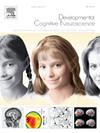外部和内部驱动的认知灵活性的共同和独特的网络基础:从发展的角度看
IF 4.9
2区 医学
Q1 NEUROSCIENCES
引用次数: 0
摘要
灵活性是认知控制的标志,可以由外部和内部驱动,对应于反应性和自发的灵活性。然而,这两种类型的灵活性之间的趋同和分化及其在发育过程中的潜在神经基础在很大程度上仍然未知。在这项研究中,我们旨在利用不同时间分辨率的横断面和纵向静息状态功能磁共振成像数据集(N = 249,6 - 35岁),确定反应性和自发灵活性的共同和独特网络。利用了分别来自静态和动态框架的功能连通性强度和节点灵活性。我们发现年龄对反应性和自发性柔韧性有相似的二次效应,这是由额顶叶网络的功能连接强度和节点柔韧性介导的。我们观察到差异,基线访问时腹侧注意网络的节点灵活性唯一地预测了24-30个月后反应性灵活性的增加,而背侧注意网络的节点灵活性或功能连接强度可以特异性地预测自发灵活性的增加。在同时测量反应性灵活性和自发灵活性的任务中发现了性别差异,这是由背侧注意网络的节点灵活性调节的。这项研究促进了我们对不同类型的认知灵活性及其在整个发育阶段的潜在机制的理解。我们的研究结果还表明,研究发育性神经精神疾病中特定类型的认知灵活性异常的重要性。本文章由计算机程序翻译,如有差异,请以英文原文为准。
Common and unique network basis for externally and internally driven flexibility in cognition: From a developmental perspective
Flexibility is a hallmark of cognitive control and can be driven externally and internally, corresponding to reactive and spontaneous flexibility. However, the convergence and divergence between these two types of flexibility and their underlying neural basis during development remain largely unknown. In this study, we aimed to determine the common and unique networks for reactive and spontaneous flexibility as a function of age and sex, leveraging both cross-sectional and longitudinal resting-state functional magnetic resonance imaging datasets with different temporal resolutions (N = 249, 6–35 years old). Functional connectivity strength and nodal flexibility, derived from static and dynamic frameworks respectively, were utilized. We found similar quadratic effects of age on reactive and spontaneous flexibility, which were mediated by the functional connectivity strength and nodal flexibility of the frontoparietal network. Divergence was observed, with the nodal flexibility of the ventral attention network at the baseline visit uniquely predicting the increase in reactive flexibility 24–30 months later, while the nodal flexibility or functional connectivity strength of the dorsal attention network could specifically predict the increase in spontaneous flexibility. Sex differences were found in tasks measuring reactive and spontaneous flexibility simultaneously, which were moderated by the nodal flexibility of the dorsal attention network. This study advances our understanding of distinct types of flexibility in cognition and their underlying mechanisms throughout developmental stages. Our findings also suggest the importance of studying specific types of cognitive flexibility abnormalities in developmental neuropsychiatric disorders.
求助全文
通过发布文献求助,成功后即可免费获取论文全文。
去求助
来源期刊

Developmental Cognitive Neuroscience
NEUROSCIENCES-
CiteScore
7.60
自引率
10.60%
发文量
124
审稿时长
6-12 weeks
期刊介绍:
The journal publishes theoretical and research papers on cognitive brain development, from infancy through childhood and adolescence and into adulthood. It covers neurocognitive development and neurocognitive processing in both typical and atypical development, including social and affective aspects. Appropriate methodologies for the journal include, but are not limited to, functional neuroimaging (fMRI and MEG), electrophysiology (EEG and ERP), NIRS and transcranial magnetic stimulation, as well as other basic neuroscience approaches using cellular and animal models that directly address cognitive brain development, patient studies, case studies, post-mortem studies and pharmacological studies.
 求助内容:
求助内容: 应助结果提醒方式:
应助结果提醒方式:


